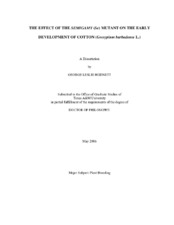The effect of the semigamy (Se) mutant on the early development of cotton (Gossypium barbadense L.)
Abstract
A stain-clearing method, which facilitated the analysis of large numbers of ovules, was developed using methyl salicylate (MS) and azure C, and used with real-time video imaging and image capture. The ability to modulate contrast and illumination intensity using video made it feasible to reduce stain intensity and thus light interference from the specimen. Samples stained and cleared were used as whole mounts which allowed the specimen to be oriented for precise analysis. Of 440 semigamous zygotes examined 439 had one egg and one sperm nucleus resulting from syngamy without karyogamy indicating semigamy is completely expressed. All phenotypes observed in semigamous cotton seedlings appear to arise as products of zygote division. Haploid and tetraploid sectors may result from relative spindle positions, orientation, and the tendency for nearby telophase chromosomes to form a common nucleus. Semigamous endosperm nuclei are triploid, but fusion was never observed. Endosperm may be a result of triple fusion or mitosis-based fusion. A slight delay in endosperm development was observed which could result from failure of the nuclei to fuse. Haploid-diploid ratios of ploidy chimeras were centered on the original 2 : 1, haploid : diploid ratio, but ratios were widely disparate among seedlings. Dispersion resulted from seeds which were chimeric for ploidy in the hypocotyls, but not in the cotyledons. Additionally, departures from the initial ploidy ratio may be a result of normal development. Differences in cell cycling may occur as cells differentiate and specialize. To examine expression of the parents on the leaves of chimeras, crosses were made between three semigamous genotypes, r1r1SeSev7v7, R1R1SeSeV7V7, and r1r1SeSeV7V7. Chimeric plants were scored for leaf color distribution. For cotyledons the average percentage of yellow-green sectors was less than the non-yellow sector, while true leaves exhibited sectoral ratios that were higher for the maternal sectors or, when confounded, for maternal plus hybrid sectors in every cross. Differences between cotyledons and true leaves may result from the differences in development. Chimeric sectors in true leaves were disproportionately derived from the maternal parent. The apparent advantage of the maternal parent may result from initial maternal developmental control.
Citation
Hodnett, George Leslie (2003). The effect of the semigamy (Se) mutant on the early development of cotton (Gossypium barbadense L.). Doctoral dissertation, Texas A&M University. Texas A&M University. Available electronically from https : / /hdl .handle .net /1969 .1 /5742.


